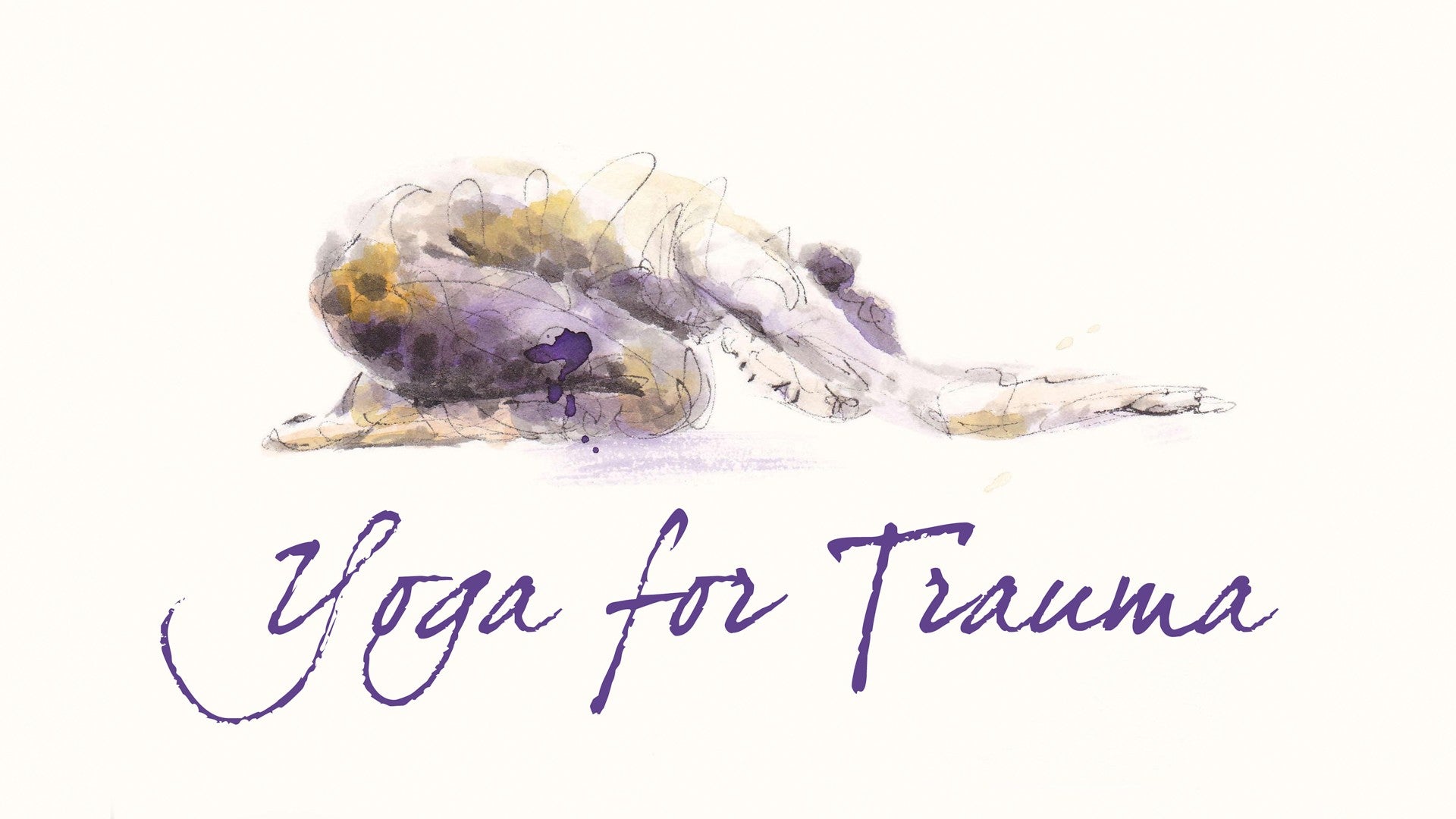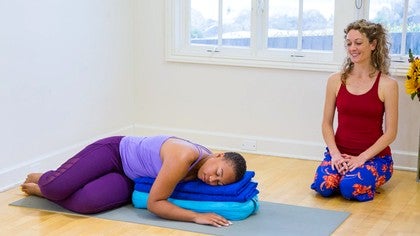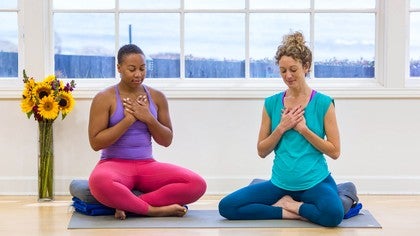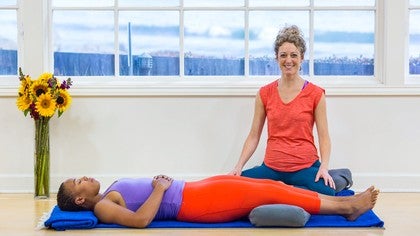Description
About This Video
Transcript
Read Full Transcript
Namaste, and welcome to this practice to really restore and recharge. I have my friend Alex here and I'm so thankful for to be demonstrating this practice. So as you're ready, we're going to bring out the props, and I'm going to suggest that you have a bolster, or if you don't have a bolster at home, that's okay. You can have maybe three blankets or two pillows, yeah? So let's move the bolster to the center.
This one's a bit on the thin side, so we're going to add a couple of blankets just to make sure that it's high enough. Great. And then come on in and we'll start with restorative child's pose. So taking the legs a little bit wider apart, and make sure that the knees are wider than the hips, particularly for your back, and then draw the bolster towards you and giving it a nice hug. You can bring it as close or as far away as is comfortable for you.
We'll hinge at the hips, laying the body down, and letting the head rest to one side. Yeah, great. And feel free, right away, you might not be in the space that feels most comfortable, so take your time to settle in and make the adjustments you need, yeah. And just begin to notice how you know this is an actual, this is actually an okay position to be in. We'll be in here for about two and a half minutes on one side, and then we'll turn our head to the other, just giving you a clue that it's not going to be forever.
And a reminder as always with our trauma-informed practice that you are always welcome to move, shift out of the position, open the eyes, close the eyes as you need, right? It's whatever allows you to stay most present, most connected, most settled, great. Now as you're becoming aware of what feels okay about this, in your mind's eye, could you give it a little bit of language, maybe, might be releasing relief, calming, quieting, yeah. Obviously any sort of sensation that allows you to know this is okay. And we're not trying to just completely zen out, though that might be a byproduct of this.
We are consciously tuning in to that interception, and if you haven't watched that talk, consider watching that talk. But the way our brain knows what our inner body is experiencing, and the interoceptive just ability to recognize what is okay, what are the sensations that are okay. Now at the two and a half minute mark, go ahead and change your head to the other side. Nice, nice. And you might be aware that gravity is helping you kind of release some of the muscles that normally hold a lot of tension, like in your lower back and in your hips.
As the system is really starting to get familiar with this posture, with this stance, quieting, keep settling. Just notice what quality of breath you have with you now. So it's not about falling asleep and just totally checking out, but it's really about checking in, checking in. It's great. And if you can be aware of the quality of breath, if that feels comfortable to you, just notice where it feels most vibrant in this shape.
It might be around your lower back and the kidney area and the adrenal glands that ride on top. Breath might be most vibrant in the belly area and it has some support against the blankets or the bolster to be really present in your awareness. Now of course your mind might wander away from this. You're human. That's what the mind does.
So when you notice that, just name it, like, oh, it's wandering, oh, it's judging, oh, it's scheduling, whatever it may be doing, just name it and come on back. Come on back, come on back to this breath, come on back to this awareness of whatever is okay. Yeah. Come on back to yourself. There you go.
Now as we move towards the very last part of this, I want you to begin to bring the breath in a little deeper and consciously move the fingers. That's it. Uh-huh. And you're going to slowly come on out of this. Slowly come on out.
Hey, system. Yeah. Great. And just being upright, notice what happens. There might be kind of a rebound of breath.
Your eyes might be a little fuzzy, or they might actually be really clear. So as you just kind of gaze around, do a moment of orienting, like, okay, I'm here. And then we're going to move into the next restorative posture, and it's a supported twist to help support the guts, the adrenal glands, the heart area. So we'll drop the knees over towards the right. Exactly.
You can move the bolster further away from yourself. Drop the knees over to the right, and kind of sit in like a mermaid, merperson, merman posture, beautiful merman, okay, mermaid. Bring the bolster in line with the hips, and you might slide it in really close, okay? And then bring the hands on either side. Come up onto the fingertips.
Great. You'll draw the spine long, taking the breath in. As you exhale, let yourself settle down onto earth. All right, mm-hmm, yeah, yeah. And notice if this feels comfortable, right?
If it doesn't, if the spine is not able to fully extend, acknowledge that you have options to take action. The time of trauma, or traumatic events, chronic stress, particularly from early developmental trauma, we don't have the capacity to take the action we need to put ourselves in more comfortable and, more importantly, safe positions. So remember, you always have the option to shift and move, mm-hmm, through the spine, through the cervical spine, yeah, yeah, yeah. So the head may feel really good one way, and then you may need to shift it into the other direction, mm-hmm, great. Just notice how you know that this is okay now.
When you start to recognize those internal messages that help your brain map an understanding of it being okay, would it be possible to allow yourself to just release to gravity a little bit more, exactly, exactly, mm-hmm, mm-hmm, great. Now slowing down can be really helpful, but if you find that as you're doing this, the actual action of slowing down is making you feel more panicky and overwhelmed, I want you to actually come out and press pause, and we'll try this practice again later. Because that can happen when your nervous system is holding a lot of overwhelm, a lot of fight and flight that hasn't exactly been processed through. Sometimes the slowing down can actually make us feel more anxious, okay, and it's not that the anxiety is bad, it's just giving you information, information that you actually need to move and maybe complete that action of safety, of running somehow, or of moving that energy somehow, all right. So really listen to those messages.
Now if the system is saying, this actually feels really great, it's nice to let go, then listen to that, all right, listen to that, mm-hmm, mm-hmm, mm-hmm, and if the mind is wondering, you might just notice, hey, it's wondering, if it's checked out, could it be okay to not put the pressure on yourself to always be here 100%, maybe allow yourself to check out for a moment, notice how that is, yeah. And now I'm gonna start to breathe in a little deeper here, of course, if this is a position you want to stay in longer, at home feel free to go ahead, but here we're gonna start to move our fingers, and then press the earth away, and again slowly, hopefully you're not just waking yourself up, yeah, and you're gonna face away from the bolsters, mm-hmm, perfect, and just slide the bolster again to really match your hips on this side, make sure you have space behind you to stretch out the legs as much as you need so you can always shift forward, got it, and then hands on either side, draw the spine long as you take the breath in, hmm, and settling down. And so we're in this about three and a half minutes as well, and notice if this side is any different, symmetry is a great idea and not a very realistic reality, so as you're here instead of any judgment as you notice differences, tightness, looseness, openness, just get curious about what is, and you may with any differences you notice, allow your mind to play between sensations, so notice what's here now on this side, the side that's closest to the bolster, mm-hmm, and then bring your brain to the other side, the more open side that's away from the bolster, and check out those sensations, and so this is a practice called pendulating, just like a pendulum will swing side to side, it's allowing the mind to move from one sensation to maybe the opposite, or one side to the opposite, mm-hmm, just back and forth, maybe five or ten seconds on your own, noticing the lower side of the body, the breath that's involved, five or ten seconds on the other side, mm-hmm, mm-hmm, and after you take a few cycles of that, release the pendulating and just notice what happens, mm-hmm, and so now I'm actually going to be quiet for the next minute or so, and just let you notice what you notice. Okay. Mm-hmm.
Great, so now as you're ready, I'm just letting the breath come in and start to move the fingers. With your breath, come on up. You got it. Then just let yourself unwind into a seated position. Take a moment to open the eyes, maybe look around and, yeah, just notice what life is like after that.
There you go. And then I'm going to come over to join you at the wall, Alex, and at home we're going to do legs up the wall. So let's move the bolster to a clear space on one of your walls at home. And for today, we are actually going to use just the thinner bolster here. Make sure it's about two inches away from your wall.
And now Alex is going to demonstrate one of the more advanced, complicated techniques in all of asana practice. So she's going to get to the very edge of the bolster. And as she lays down, she's going to swivel the legs up towards the wall. I'm going to move back here to give you a little space. And then make sure the bolster is exactly where you want it.
So if it needs to be a little bit further away from the wall or more underneath your sacrum, go ahead and adjust until it's there. And now your arms, your arms can be anywhere you want them to be. They might be on your belly, one hand on your heart, they might be out to the side. I personally always really like cactuses or arms up overhead, whatever might feel a place that will allow you or a position that will allow you to let go. Now for some of us, this is actually a hamstring stretch.
So if the backs of your legs are tight, unlock the knees a little bit. We'll be here for now about four more minutes. Eyes of course can be open or closed. If they're open, consider letting the gaze be really gentle. So it's almost like you're just placing your sight on an object or an image, texture, color, and you're really letting your eyes kind of soften.
Just a suggestion. You might notice this, how you're really reversing the action of gravity on the body. The blood flow moving down from the feet, releasing through the joints, pressure in the opposite direction on the hips and the low back. Sensations connected to this might really be some tingling, some pins and needles, some flow, heat, expansion. And checking in over and over, just where am I?
How do I know this is okay? How do I know this isn't okay? And if it isn't okay, can I actualize my choice to shift? Now if you are elevated a bit on a bolster or a few blankets, you might even sense the blood flow going through the lower back, through the kidneys, through the stomach, the heart, and into the throat. Legs up the wall is said to be like the five minute rejuvenator, so if you have a lot of energy it'll help kind of balance it out.
If you have a little energy, it can really help support and lift your inner sense of kind of vitality. Definitely massages the thyroid and the parathyroid, all of these part of the endocrine system that gets kind of fragmented, dysregulated or a little wonky when we are dealing with chronic stress or trauma. And if possible, if this feels like a space that allows you to settle, you might give yourself permission to just receive anything that is sweet and nourishing and kind about this experience. So I'm going to be quiet for the next minute or so. Just notice again what you notice.
Okay. Hmmmm. And starting to deepen the breath, yeah, uh-huh, exactly, we'll take one more cycle of inhales and on your exhale consider opening the mouth and just letting it, right, move the fingers, the toes, hug your knees into the chest, right, beautiful. You might even, even if it seems a little silly, say to yourself, I love myself, yeah, and then go ahead and reach the arm alongside of the ear, one arm, uh-huh, roll over towards that arm, uh-huh, off the bolster, take it a moment or two to just transition, uh-huh, yeah, yeah, yeah, yeah. And then you're going to rise up, uh-huh, okay, come seated, nice, uh-huh, okay, come seated, nice, take a moment to rub your hands, yeah, right, uh-huh, place the hands over the eyes, do a little massage in the temples, forehead, bring the hands down to the neck, the base of the skull, the shoulders, let your eyes open, go ahead and do that, orienting, how are the colors now, mm-hmm, yeah, great, and bringing the palms together, bowing in, thank you, thank you, namaste.
Yoga for Trauma
Comments
You need to be a subscriber to post a comment.
Please Log In or Create an Account to start your free trial.










